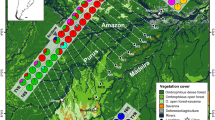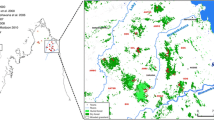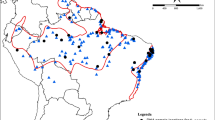Abstract
The Rufous Gnateater, Conopophaga lineata, is a small insectivorous understory bird which is endemic to and widely distributed in the tropical and subtropical Atlantic forest of South America. Its distribution makes it ideally suited for testing two major hypotheses for the origin of biodiversity, namely, the riverine barrier and the forest refuge hypotheses. In this study, we sequenced mitochondrial (control region) and nuclear markers (intron 5 of the β-fibrinogen gene) for individuals distributed in the southern Atlantic forest and obtained a strong genetic structure with one clear discontinuity in northern Brazilian state of São Paulo. We consistently detected signals of demographic expansion for both markers, with estimates indicating that expansion started in the Late Pleistocene (250,000 years ago), suggesting that the forest refuge hypothesis potentially explains Rufous Gnateater’s diversification. We also found evidence of gene flow between populations from each side of this discontinuity, with a possible secondary contact zone occurring in the states of Minas Gerais, São Paulo, and Rio de Janeiro.
Zusammenfassung
Die populationsgenetische Struktur des in der Mata Atlântica endemischen Rotkehl-Mückenfressers ( Conopophaga lineata , Passeriformes: conopophagidae) lässt eine Kontaktzone in der Mata Atlântica erkennen
Der Rotkehl-Mückenfresser, Conopophaga lineata, ist ein kleiner insektivorer Vogel, der im Unterholz der tropischen und subtropischen Mata Atlântica in Südamerika endemisch und weit verbreitet ist. Die Verbreitung des Rotkehl-Mückenfressers macht ihn besonders dafür geeignet, zwei Haupthypothesen zum Ursprung von Biodiversität zu testen, die „Flüsse als Barrieren“-Hypothese (“riverine barrier hypothesis”) und die „Wälder als Rückzugsgebiete“-Hypothese (“forest refuges hypothesis”). Wir haben mitochondriale Marker (Kontrollregion) und Zellkernmarker (Intron 5 von β-Fibrinogen) für in der südlichen Mata Atlântica verbreitete Individuen sequenziert und eine ausgeprägte genetische Struktur mit einer klaren Diskontinuität im Norden des Bundesstaates São Paulo gefunden. Für beide Marker haben wir durchweg Signale demographischer Ausbreitung entdeckt, die schätzungsweise im späten Pleistozän (vor 250000 Jahren) begann, was darauf hindeutet, dass die „Wälder als Rückzugsgebiete“-Hypothese einen möglichen Einflussfaktor bei der Diversifikation des Rotkehl-Mückenfressers darstellt. Wir haben auch Hinweise auf Genfluss zwischen Populationen auf beiden Seiten der Diskontinuität gefunden, mit einer möglichen sekundären Kontaktzone in den Bundesstaaten Minas Gerais, São Paulo und Rio de Janeiro.






Similar content being viewed by others
References
Amaro RC, Carnaval AC, Yonenaga-Yassuda Y, Trefaut MR (2012) Demographic processes in the montane Atlantic rainforest: molecular and cytogenetic evidence from the endemic frog Proceratophrys boiei. Mol Phylogenet Evol 63:880–888
Axelsson E, Smith NGC, Sundstrom H, Berlin S, Ellegren H (2004) Male-biased mutation rate and divergence in autosomal, Z-linked and W-linked introns of chicken and turkey. Mol Biol Evol 21:1538–1547
Bandelt HJ, Forster P, Rohl A (1999) Median-joining networks for inferring intraspecific phylogenies. Mol Biol Evol 16:37–48
Batalha-Filho H, Cabanne GS, Miyaki CY (2012) Phylogeography of an Atlantic Forest passerine reveals demographic stability through the last glacial maximum. Mol Phylogenet Evol 65:892–902
Behling H (2002) South and southeast Brazilian grasslands during late quaternary times: a synthesis. Palaeogeogr Paleoclimatol Palaeoecol 177:19–27
Behling H, Pillar VDP (2007) Late quaternary vegetation, biodiversity and fire dynamics on the southern Brazilian highland and their implication for conservation and management of modern Araucaria forest and grassland ecosystems. Phil Trans R Soc B 362:243–251
Brown KS (2005) Geological, evolutionary, and ecological bases of the diversification of neotropical butterflies: implications for conservation. In: Berminhgam E, Dick CW, Moritz C (eds) Tropical Rainforest: past present and future. University of Chicago Press, Chicago, pp 166–200
Brown KS, Ab’Saber AN (1979) Ice-age forest refuges and evolution in Neotropics: correlation of paleoclimatological, geomorphological and pedological data with biological endemism. Paleoclimas 5:1–30
Bruford MW, Hanotte O, Brookfield JFY, Burke T (1992) Single-locus and multilocus DNA fingerprinting. In: Hoelzel AR (ed) Molecular genetic analysis of populations—a practical approach. IRL Press, New York, pp 287–336
Cabanne GS, Santos FR, Miyaki CY (2007) Phylogeography of Xiphorhynchus fuscus (Passeriformes, Dendrocolaptidae): vicariance and recent demographic expansion in southern Atlantic Forest. Biol J Linn Soc 91:73–84
Cabanne GS, d’Horta FM, Sari EH, Santos FR, Miyaki CY (2008) Nuclear and mitochondrial phylogeography of the Atlantic Forest endemic Xiphorhynchus fuscus (Aves: dendrocolaptidae): biogeography and systematics implications. Mol Phylogenet Evol 49:760–773
Cabanne GS, D´Horta FM, Meyer D, Silva JMC, Myiaki CY (2011) Evolution of dendrocolaptes platyrostris (Aves:Furnariidae) between the south American open vegetation corridor and the Atlantic Forest. Biol J Linn Soc 103:801–820
Cabanne GS, Sari HER, Meyer D, Santos FR, Miyaki CY (2012) Matrilineal evidence for demographic expansion, low diversity and lack of phylogeographic structure in the Atlantic forest endemic Grenish Schiffornis Schiffornis virescens (Aves: tityridae). J Ornithol 154:371–384
Carnaval AC, Moritz C (2008) Historical climate modeling predicts patterns of current biodiversity in the Brazilian Atlantic Forest. J Biogeogr 35:1187–1201
Carnaval AC, Hickerson MJ, Haddad CFB, Rodrigues MT, Moritz C (2009) Stability predicts genetic diversity in the Brazilian Atlantic forest hotspot. Science 323:785–789
Corander J, Tang J (2007) Bayesian analysis of population structure based on linked molecular information. Math Biosci 205:19–31
Costa LP, Leite YLR, da Fonseca GAB, da Fonseca MT (2000) Biogeography of south American forest mammals: endemism and diversity in the Atlantic forest. Biotropica 32:872–881
Costa LP (2003) The historical bridge between the Amazon and the Atlantic Forest of Brazil: a study of molecular phylogeography with small mammals. J Biogeogr 30:71–86
d’Horta F, Cabanne GS, Meyer D, Miyaki CY (2011) The genetic effects of late quaternary climatic changes over a tropical latitudinal gradient: diversification of an Atlantic Forest passerine. Mol Ecol 20:1932–1935
Dantas GPM, Santos FR, Marini MÂ (2007) Genetic variability of Conopophaga lineata (Conopophagidae) in Atlantic Forest fragments. Braz J Biol 67:631–637
Dantas GPM, Santos FR, Marini MÂ (2009) Efeitos de fragmentação na razão sexual de Conopophaga lineata em fragmentos de Mata Atlântica no Estado de Minas Gerais. Iheringia Série Zool 99:115–119
Drummond AJ, Rambaut A (2007) BEAST: bayesian evolutionary analysis by sampling trees. BMC Evol Biol 7:214
Excoffier L, Lischer HLE (2010) Arlequim ver 3.5: a new series of programs to perform population genetics analyses under Linux and Windows. Mol Ecol Res 10:564–567
Fitzpatrick SW, Brasileiro CA, Haddad CF, Zamudio KR (2009) Geographical variation in genetic structure of an Atlantic coastal forest frog reveals regional differences in habitat stability. Mol Ecol 18:2877–2896
Fu Y-X, Li WH (1993) Statistical tests of neutrality of mutations. Genetics 133:693–709
Geise L, Smith MF, Patton JL (2001) Diversification in the genus Akodon (Rodentia: sigmodontinae) in southeastern South America: mitochondrial DNA sequence analysis. J Mamm 82:92–101
Grazziotin FG, Monzel M, Echeverrigarauy S, Bonato SL (2006) Phylogeography of the Bothrops jararaca complex (Serpentes: viperidae): past fragmentation and island colonization in the Brazilian Atlantic Forest. Mol Ecol 15:3969–3982
Gusmão Câmara I (2003) Brief history of conservation in the Atlantic forest. In: Galindo-Leal C, Gusmão Câmara I(eds). The state of the hotspots: The Atlantic Forest. Island Press, Washington DC, pp 31–42
Haffer J (1969) Speciation in Amazonian forest birds. Science 165:131–137
Haffer J, Prance GT (2001) Climatic forcing of evolution in Amazonia during the Cenozoic: on the refuge theory of biotic differentiation. Amazoniana 16:579–605
Hall TA (2001) BioEdit: a user-friendly biological sequence alignment editor and analysis program for Windows 95/98/NT. Nucleic Acids Symp Ser 41:95–98
Heled J, Drummond AD (2008) Bayesian inference of population size history from multiple loci. BMC Evol Biol 8:289
Hey J, Nielsen R (2004) Multilocus methods for estimating population sizes, migration rates and divergence time, with applications to the divergence of Drosophila pseudoobscura and D. persimilis. Genetics 167:747–760
Lacerda DR, Marini MÂ, Santos FR (2007) Mitochondrial DNA corroborates the species distinctiveness of the Planalto (Thamnophilus pelzelni Hellmayr, 1924), the Sooretama (T. ambiguus Swainson, 1825) Slaty-antshrikes (Passeriformes: thamnophilidae). Braz J Biol 67:873–882
Librado P, Rozas J (2009) DnaSP v. 5: a software for comprehensive analysis of DNA polymorphism data. Bioinformatics 25:1451–1452
Maldonado-Coelho M (2012) Climatic oscillations shape the phylogeographical structure of Atlantic forest fire-eye antbirds (Aves: thamnophilidae). Biol J Linn Soc 105:900–924
Marini MÂ, Hackett SJ (2002) A multifaceted approach to the characterization of an intergeneric hybrid manakin (Pipridae) from Brazil. Auk 119:1114–1120
Martins FM (2009) The Brazilian Atlantic Forest historical biogeography and the Carnaval-Moritz model of Pleistocene refugia: what do the phylogeographical studies tell us? Biol J Linn Soc 104:499–509
Miranda JM, Bernardi IP, Passos FC (2006) A new species of Eptesicus (Mammalia: chiroptera) from Atlantic Forest Brazil. Zootaxa 1383:57–68
Moritz C (2002) Strategies to protect biological diversity and the evolutionary process that sustain it. Syst Biol 51:238–254
Mustrangi MA, Patton JL (1997) Phylogeography and systematics of the slender mouse opossum Marmosops (Marsupialia: didelphidae). Univ Calif Publ Zool 130:1–86
Nielsen R, Wakeley J (2001) Distinguishing migration from isolation: a Markov chain Monte Carlo approach. Genetics 158:885–896
Pavan AC, Martins FM, Santos FR, Ditchfield A, Redondo RAF (2011) Patterns of diversification in two species of short-tailed bats (Carollia Gray, 1838): the effects of historical fragmentation of Brazilian rainforests. Biol J Linn Soc 102:527–539
Pellegrino KCM, Rodrigues MI, Waite AN, Morando M, Yassuda YY, Sites JW (2005) Phylogeography and species limits in the Gymnodactylus darwinii complex (Gekkonidae, Squamata): genetic structure coincides with river systems in the Brazilian Atlantic Forest. Biol J Linn Soc 85:13–26
Pessoa RO (2007) Sistemática e Biogeografia Histórica da Família Conopophagidae (Aves: Passeriformes): Especiação nas Florestas da América do Sul. PhD thesis. Instituto de Biociências da Universidade de São Paulo, São Paulo
Petri S, Fulfaro VJ (1983) Geologia do Brasil—Fanerozoico. Editora da Universidade de São Paulo, São Paulo
Polzin T, Daneschmand SV (2003) On Steiner trees and minimum spanning trees in hypergraphs. Oper Res Lett 31:12–20
Posada D, Cradall KA (1998) Modeltest: testing the model of DNA substitution. Bioinformatics 14:817–818
Ramos-Onsins SE, Rozas J (2002) Statistical properties of new neutrality tests against population growth. Mol Biol Evol 19:2092–2100
Ribeiro MC, Metzger JP, Martensen AC, Ponzoni FJ, Hirota MM (2009) The Brazilian Atlantic Forest: how much is left, and how is the remaining forest distributed? Implications for conservation. Biol Conserv 142:1141–1153
Riccomini C, Peloggia AUG, Salón JCL, Kohner MW, Figueira RM (1989) Neotectonic activity in the Serra do Mar rift system (southeastern Brazil). J South Am Earth Sci 2:191–197
Salisbury CL, Seddon N, Cooney CR, Tobias JÁ (2012) The latitudinal grandient in dispersal constraints: ecological specialization drivers diversification in tropical birds. Ecol Lett 15:847–855
Sick H (1997) Ornitologia Brasileira. Nova Fronteira, Rio de Janeiro 912p
Sigrislt T (2005) Aves do Brasil: uma visão artística. Editora Avis Brasilis, São Paulo
Silva JMC, Straube FC (1996) Systematics and biogeography of scaled woodcreepers (Aves: dendrocolpatidae). Stud Neotrop Fauna Environ 31:3–10
Silva JMC, De Sousa MC, Castelleti CHM (2004) Areas of endemism for passerine birds in Atlantic Forest, South America. Glob Ecol Biog 13:85–93
Stephens M, Donnelly P (2003) A comparison of Bayesian methods for haplotype reconstruction from population genotype data. Am J Hum Genet 73:1162–1169
Stephens M, Smith NJ, Donnelly P (2001) A new statistical method for haplotype reconstruction from population data. Am J Hum Genet 68:978–989
Tajima F (1989) Statistical method for testing the neutral mutation hypothesis by DNA polymorphism. Genetics 123:585–595
Vanzolini PE, Williams EE (1970) South American anoles: the geographic differentiation and evolution of the Anolis chrysolepis species group (Sauria: iguanidae). Arq Zool 19:1–298
Wallace AR (1852) On the monkeys of the Amazon. Proc Zool Soc London 20:107–110
Weber LN, Gonzaga LP, Carvalho-e-Silva SP (2005) A New species of Physalaemus from the lowland Atlantic Forest of Rio de Janeiro State Brazil (Amphibia, Anura, Leptodactylidaea). Arq Mus Nac 63:677–684
Weir JT, Schluter D (2008) Calibrating the avian molecular clock. Mol Ecol 17:2321–2328
Whitney BM (2003) Family Conopophagidae. In: del Hoyo J, Elliot A, Christie DA (eds) Handbook of the birds of the world: Broadbills to Tapaculos, vol 8. Lynx Edicións, Barcelona, pp 732–747
Willis EO, Oniki Y, Silva WR (1983) On the behaviour of Rufous Gnateaters (Conopophaga lineata, Formicariidae). Naturalia 8:67–93
Zink RM, Barrowclough GF (2008) Mitochondrial DNA under siege in avian phylogeography. Mol Ecol 17:2107–2121
Acknowledgments
This work was supported by FAPEMIG (Fundação de Amparo a Pesquisa do Estado de Minas Gerais 17228), CNPq, FAPESP (BIOTA 2013/50297-0), NSF (DOB 1343578), NASA, CAPES (Coordenação de Aperfeiçoamento de Pessoal de Nível Superior), and the Research Center on Biodiversity and Computing (BioComp) of the Universidade de São Paulo (USP), supported by the USP Provost’s Office for Research. Gisele Dantas worked under a Post-doctoral grant CAPES/PNPD (2010/52590-8) and CNPq (503145/2009-2). We also thank the Instituto Brasileiro do Meio Ambiente e dos Recursos Naturais Renováveis (Brazil), Instituto Florestal de São Paulo (Brazil), and Instituto Estadual de Florestas de Minas Gerais (Brazil) for the permits to collect samples (IBAMA/MMA no 03/2004 IBAMA/MMA: 011/2000, processes 1835/2000; 053/2001, 1835/00-07; 070/2002, 02015.001835/00-07; 207/2003, 02015.023482/98-38). We gratefully acknowledge the improvements in English usage made by Caitlin Stern through the Association of Field Ornithologists’ program of editorial assistance.
Author information
Authors and Affiliations
Corresponding author
Additional information
Communicated by J. Fjeldså.
Appendix
Appendix
See Table 5.
Rights and permissions
About this article
Cite this article
Dantas, G.P.M., Sari, E.H.R., Cabanne, G.S. et al. Population genetic structure of the Atlantic Forest endemic Conopophaga lineata (Passeriformes: Conopophagidae) reveals a contact zone in the Atlantic Forest. J Ornithol 156, 85–99 (2015). https://doi.org/10.1007/s10336-014-1106-0
Received:
Revised:
Accepted:
Published:
Issue Date:
DOI: https://doi.org/10.1007/s10336-014-1106-0




